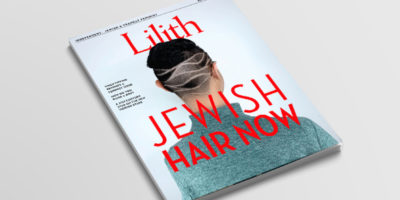
The Social Context of Hair: Hairstyles, Race and Status
HAIR IS PERSONAL. Hair is political. To make sense of the social context of hair for Jews of color today, SARAH SELTZER talked to CHAVA SHERVINGTON, a longtime diversity activist in the Jewish community, as well as an attorney and mom, who by her own admission has become “obsessed with hair issues” as she helps her kids navigate the complex politics of their Black hair.
What is it about hair that provokes such intense political and
emotional reactions?
In society, hair has become both this integral part of a woman’s beauty and self-identity and at the same time communicates messages to the broader world. When the natural hair movement first started, I remember how political that was. What are you saying about yourself, your politics, your age, your economic status? There are so many different things that you’re signaling through your hair.
Why has it been on your mind recently?
The politics of hair has become my recent passion because of my kids—they got the braids that I never got. I wanted cornrows so badly as a kid because there was a perception that only low-income kids from “certain backgrounds” wore those hairstyles. My kids are the only black kids in their Jewish schools. Since they got braids, everybody wants to touch their hair. It caused anxiety for me and my husband, because our daughter was so happy about her hair and we didn’t want her to experience negativity. It’s difficult—at school, the images in the books they look at are not diverse. Which is hard because kids are always looking for themselves in the media. At home, we have been supplementing with books like Hair Love and talking to them about adding a specialness and self-confidence around their own hair, where it’s neither fetishized nor misunderstood.
What’s a good guiding principle for how we treat other people’s hair, especially across different backgrounds?
Approach it in a positive way, sure, but there’s a level of
enthusiasm where it becomes fetishistic. You want to pay a
compliment but not create a sense of otherness or discomfort!
One thing that has become increasingly clear recently is how workplace rules around hairstyles amount to legal discrimination.
There is clear discrimination around what’s seen as professional vs. unprofessional. For instance, the interview advice in law school was: pull your hair back in a ponytail, it should be straight, women of color, hair should be relaxed. Natural hair wasn’t even contemplated. When people talk to you about meetings and performance reviews or they might say, “Her hair is distracting.” The military had an issue—they caught a lot of flak for prohibiting hairstyles that are low-maintenance for women. And many school districts have prohibitions on different types of braids, specifically cornrows—vs. one or two French braids, a style that isn’t really possible for a lot of black hair. When my girls started school, I looked at my daughters’ uniform rules. Because oftentimes the rules don’t really envision children of color in those spaces. It’s a product of a kind of colorblindness where we keep each other the same, but it doesn’t take into consideration that your hair is completely different. People are starting to recognize that colorblindness reinforces a specific version of whiteness: as we envision ourselves as a multi-racial, multi-ethnic society, we have to shift our institutional policies and how we think about some of those things, like hair.
In New York and California we saw new laws banning
discrimination against hairstyles: will it help?
I’ve been following it and I’m really interested in how it gets enforced. Where institutions have specific guidelines around hair, I see how these laws will do good. But so much of the problem comes from vagueness and neutrality: “Your hair must be a professional style” or “Our clients have made statements about your hair.” Even the question “Does she fit in with our company culture?” All these things are buzzwords for exclusion.
Is it possible that a discussion of hair can lead us to more
solidarity and understanding?
Yes and no. Because yes, all of us were struggling as teenagers when we started to do our own hair and that struggle often resulted in poor school pictures! But for all that we have shared narratives, the external world we live in means there’s a danger in just equating our experiences. So we can use hair storytelling as a tool to bring people in to understand how oppression occurs, but it can’t just be a “universal experience.”
How does this all play out within the Jewish community?
In the Orthodox world there are not a lot of rabbis who are well-versed in topics of natural hair. What if someone has dreadlocks and wants to do mikveh? A lot of rabbis will just say no. It will be interesting to see how certain halachot [laws] like this will be impacted by increasing numbers and voices of Jews of color. And when you look at the universe of Jewish books, diverse books don’t exist in quantities that make a large dent. One thing that would be really great is if makers of Jewish media made it a priority to diversify the representation of Jewish kids out there. The saying goes, “If you can’t see, it you can’t be it.”



